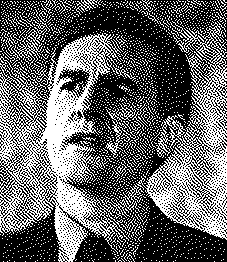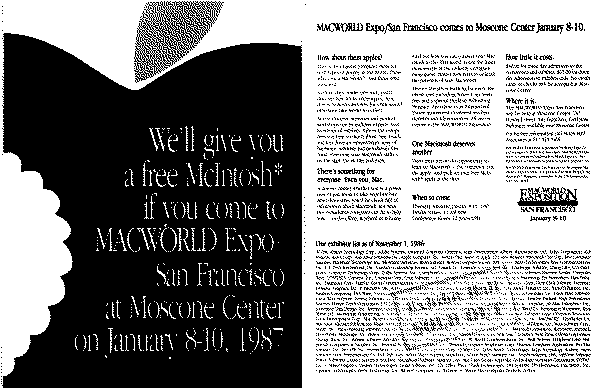Macworld Expo 1987 San Francisco
1,012 words
10K on disk
January 1987
 Macworld Expo 1987 San Francisco
Macworld Expo 1987 San Francisco
Trade Show

Dates: January 8-10 1987
Cost: $40 Conference and Exhibits, $15 Exhibits only
Exhibitors: 250
Keynote
 John Sculley on Intelligent Documents
John Sculley on Intelligent Documents
Sculley made the claim that the industry was moving away from data and towards intelligent documents. He named what he called ‘second-generation’ DTP products such as Adobe Illustrator
Intelligent documents will have as much impact in changing the environment of the business world as the telephone had at the beginning of the century or the Xerox machine has had in the last two decades.
For the first time in our history, we know what our products will be, not just in 1987, but in 1988, 1989, and on into the 1900s. Our Cray is being used to simulate the products we will put into silicon and bring into the marketplace in the 1990s. We have a clear vision of where we want our company to go.
It’s not completely what Sculley meant by “intelligent documents,” but one is tempted to think about a feature which would ship in 1991 in System 7: Publish and Subscribe. At any rate, Sculley also mentions “Intelligent Documents” in his 1988 book Odyssey, which is a source I’ll read in the future for clues to this concept.
Summary
“MacWorld Expo had the enthusiasm we used to see at all the computer shows but now is only for the Macintosh, Atari and Amiga.” — Jerry Pournelle
Seminar Topics
- Business Applications of Macintosh Graphics
- Desktop Communications
- Maximizing Macs in the Office Environment
Apple
No major Apple hardware announcements, but the AppleShare software made its debut, together with the AppleTalk PC Card (really a LocalTalk hardware interface with a AppleTalk protocol stack). Rumors of the upcoming Apple File Server placed it at between $500 and $1000, and whispers placed its introduction at the Seybold Seminar in the coming weeks. (It never actually shipped, and was a major reason why the “Macintosh Office” concept was more vapor than reality.)
Word Processing
The line between word processing and DTP begins to blur as Word, FullWrite and WordPerfect adopt layout features such as hyphenation and wrapping text around irregular objects. (See, however, the continuing delays which plagued FullWrite after its promising introduction at this Expo.) The idea that word processors would expand into the DTP market was current at this time — in February, Computer Chronicles quoted no less a source than Steve Jobs as saying DTP would soon cease to exist as a distinct market.
Desktop Publishing
Despite the encroachment of word processors, dedicated DTP software maintained a presence at the Expo. ReadySetGo 3.0 beat out PageMaker 2.0 in terms of size and scale of demonstrations and public attention. According to some attendees, Aldus gave no public demo of their product, but was showing it to the press behind closed doors. I don’t know if the following video was the result of such a press briefing, or if it actually shows version 1.0 running:
The fact that PageMaker 2 would ship on the PC before the Mac heralded Adobe’s increasing cross-platform focus, much to the dismay of show attendees.
Spreadsheets
Excel 1.03 jumped on the bandwagon of larger-screen support, reflecting the reality of a marketplace where external displays from companies such as Radius had helped transform the reputation of the Mac from toy to serious tool.
Trapeze, from Data Tailor, got a lot of attention during this Expo as a kind of next-generation spreadsheet — I’ll try to write up a separate post on this app in the future. In the meantime, read this review of version 2, released 9 months later.
Graphics
Illustrator, the brand-new vector drawing tool from Adobe, made even sophisticated raster programs such as SuperPaint look like yesterday’s news. Yet people weren’t really sure how an object-oriented drawing system would work: there was as much emphasis on tracing an outline of scanned artwork as there was on creating drawings from whole cloth.
As seen in the above video, Adobe was showing off their new program at both their booth and at that of Radius — again showing the importance of that hardware company in the Mac marketplace.
Productivity
Living Videotext upgraded its MORE outliner to 1.1 — now with Undo! It’s striking to run across the Dave Winer of 24 years ago: he was then president of the company. MORE 1.1 also offered styled text and hierarchical outlining, two features we take for granted today. Also fascinating that there was a market for $300 outliners back in 1987. But MORE wasn’t even the only such product — Symmetry likewise showed off Acta 1.2 (now with printing!). And Borland showed off an their PIM product, SideKick.
Utilities
This might be a record for a product’s longevity: CE Software introduced DiskTop at this Expo, which as of 2011 was still for sale and working (at least in Classic and on PowerPC Macs). You can read a review of the modern version DiskTop from 2000 (when it was already considered a miracle of survival) from TidBits.
In keeping with the DTP theme of the show, Think Technologies was selling a $100 print spooler called LaserSpeed.
Peripherals
Supermac introduced both tape backup drives as well as external hard drives.
A company called Lodown (?) also showed off a 32-shade greyscale SCSI scanner for a mere $1,300.
Networking
In keeping with Macintosh Office fever, Kinetics showed off a SCSI/Ethernet adaptor for the Mac Plus. (Can you just imagine how slow that would be?) At least the price was reasonable, only $1,250. Reading these stories really makes you realize how much different the world was in ’87: getting a faster network to the slowest machine Apple sold was worth an investment of well over a thousand dollars. This tells you something about the costs of faster and more capable systems.
Think Technologies showed off Inbox for Mac, one of several LAN-based email systems that would briefly flourish, before dying off in the Internet era. Hard to believe the per-seat cost was $125.


